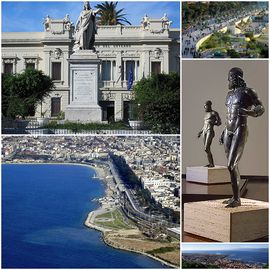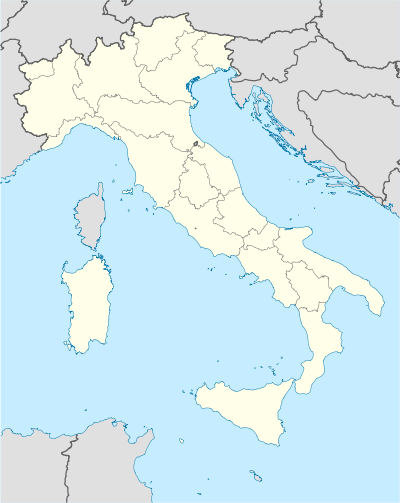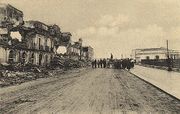Reggio Calabria
| Reggio Calabria | |||
|---|---|---|---|
| — Comune — | |||
| Città di Reggio Calabria | |||
 |
|||
|
|||
 |
|||
 Reggio Calabria
|
|||
| Coordinates: | |||
| Country | Italy | ||
| Region | Calabria | ||
| Province | Reggio Calabria (RC) | ||
| Founded | 720 BC[1] | ||
| Government | |||
| - Mayor | Giuseppe Scopelliti (PdL) | ||
| Area | |||
| - Total | 236 km2 (91.1 sq mi) | ||
| Population (30 June 2009)[2] | |||
| - Total | 186,134 | ||
| - Density | 788.7/km2 (2,042.7/sq mi) | ||
| Time zone | CET (UTC+1) | ||
| - Summer (DST) | CEST (UTC+2) | ||
| Postal code | 89100 | ||
| Dialing code | 0965 | ||
| Patron saint | Saint George | ||
| Website | Official website | ||
Reggio di Calabria (Italian pronunciation: [ˈrɛdʒːo ˌdi kaˈlabrja]; Calabrian dialect: Rìggiu, Greek-Calabrian: Righi, Greek: Ῥήγιον- Rhegion), commonly known as Reggio Calabria listen or Reggio, is a city and comune located in Calabria in southern Italy, and the capital of the Province of Reggio Calabria.
Reggio di Calabria is located on the toe of the Italian peninsula and is separated by the Strait of Messina from the island of Sicily. It is situated on the slopes of the Aspromonte, a long, craggy mountain range that runs up through the center of the region. The region is subject to earthquakes and tsunami. It is the largest and oldest city in the region and is the second oldest city in Italy overall. The third economic center of mainland Southern Italy, it is well known as a port and university city.
It is called the "city of Bronzes", for the Riace bronzes, testimonials of its Greek origins; the "city of Bergamot", which is exclusively cultivated in the region; as well as the "city of Fatamorgana", an optical phenomenon visible only from the Reggio seaside in Italy. The city has a population of 186,134 spread over 236 km², while the fast-growing urban area numbers 260,000 inhabitants. Another 370,429 people live in the metropolitan area (the 10th metropolitan city of the Italian nation).
Founded in 720 BC[1] by the Ancient Greeks as Rhegion (meaning "it breaks away"), the settlement was a well established part of Magna Graecia. Later it became a Roman ally and part of the Roman Republic, then metropolis and capital of the possessions of the Byzantine Empire in southern Italy (from 553 to 1071). Reggio emerged as the capital of the Duchy of Calabria for a period until it was incorporated into the Kingdom of Sicily. It was then part of the Kingdom of Naples, later known as Two Sicilies, from 1282 to 1860, until the Italian unification.
Contents |
Industry
Reggio retains a somewhat rural ambience despite its sizable population. Industry in the city revolves primarily around agriculture and the exportation of fruits and tobacco. Also as Reggio is a port city, it has a fishing industry. The beaches of the city have helped make it a popular tourist destination.[3] The municipality of Reggio Calabria contains the frazioni (subdivisions, mainly villages and hamlets) Catona, Gallico, Archi, Pentimele, Gallina, Mosorrofa (Greek: Messorofè), Ortì (Greek: Orthioi), Pellaro (Greek: Pèllaros), Saracinello.
History
Ancient history

After Cumae, Reggio is one of the oldest Greek colonies in southern Italy. The colony was settled by the inhabitants of Chalcis and Messenia in 720 BC on the site of an older settlement, Erythrà (Ερυθρά), meaning "the red one". This dated back to the 3rd millennium BC and was established by the Ausones. The last Ausonian ruler was the legendary king Italus (from whom the name of Italy is derived).[4] King Iokastos is buried on the Punta Calamizzi promontory, called "Pallantiòn", where Greek settlers later arrived. The colony retained the earlier name of "Rhegion" (Ρήγιoν).
Reggio was one of the most important cities in Magna Grecia, reaching great economic and political power during the 5th and 6th centuries BC under the Anaxilas government. It allowed Reggio to rule over all the Strait, including Zancle (modern Messina). Later, the polis of Rhegion reached great artistic and cultural heights with its philosophic Pythagorean school, as well as sculpture and poetry schools, from where came leaders such as Pythagoras of Rhegium and Ibycus. Later, Rhegion allied with Athens during the Peloponnesian War but in 387 BC, the city was taken by the Syracusans.
As an independent city, Rhegium was an important ally and "socia navalis" of Rome. Then during the Imperial age it became one of the most important and flourishing cities of southern Italy because it was the seat of the "Corrector", the Governor of the "Regio II Lucania et Bruttii" (province of Lucany and Brutium). It was devastated by several major earthquakes and associated tsunami during the Roman Empire when it was called "Rhegium Julium." It was a noble Roman city.
During the Byzantine Age, Reggio became the capital of the "metropolis of the Byzantine possessions in southern Italy", and later capital of the Duchy of Calabria and linchpin of the Greek church in Italy. During the 8th century, the city became a Holy See.
Middle Ages

Because of the city's strategic importance, numerous occupying armies came to Reggio Calabria during the early Middle Ages. For hundreds of years, Reggio was contested between the Saracens (who established a self-proclaimed sultanate on the Southern Italian coast under Mofareg-ibn-Salem which at its peak reached from Bari to Reggio Calabria, lasting from approximately 853 to 871)[5] and Lombards, and then between the Byzantines and Normans. In 1060, Robert Guiscard and Roger I of Sicily finally captured Reggio, but Greek cultural and religious elements persisted until the 17th century.
In the 12th century, Reggio became part of the Kingdom of Sicily. In 1282, during the Sicilian Vespers, Reggio rallied in support of Messina and the other oriental Sicily cities because of the shared history, commercial and cultural interests. It supported the Aragonese forces against the House of Anjou. The city was ranked to Kingdom of Naples. In the 14th century, it obtained larger, new administrative powers.
Reggio Calabria is known as the location of the first dated Hebrew book, a Rashi commentary on the Pentateuch, printed in 1475;[6] however, scholars consider Rome as the city where Hebrew printing began.
Modern history

Because of continuous Turkish incursions, pestilences, and the oppressive Spanish domination taxes, the power of Reggio began to decay in the 16th century until the disastrous 1783 earthquake. The quake damaged not only Reggio but all southern Calabria and Messina.
In 1806 Napoleon Bonaparte took Reggio and assigned the city as Ducate and General Headquarters. On August 21, 1860 during the famous "Battaglia di Piazza Duomo" (Cathedral Square Battle), Giuseppe Garibaldi conquered the Kingdom of the Two Sicilies. Brun Antonio Rossi - the mayor of Reggio - was the first of the Kingdom to proclaim the Francis II decline and the new Garibaldi Dictatorship.

On December 28, 1908, at exactly 5:21 AM, the town was hit by a heavy earthquake and shook violently for a long 31 seconds. Damage was even worse in Messina across the Straits. It is estimated that 25,000 people perished in Reggio Calabria and 65,000 in Messina. Reggio lost 27% of its inhabitants; Messina lost 42%. Ten minutes after the catastrophic earthquake those who tried to escape running towards the open spaces of the coast were engulfed by a 10 metre high tsunami. Three tidal waves measuring 6–12 meters swept away the whole waterfront. The 1908 Messina earthquake remains one of the worst on record in modern western European history.[7][8] It took Reggio a generation to fully recover.
The city was rebuilt to modern standards but because of its strategic military position, it suffered a devastating air raid by the English 8th Army in 1943. After the Second World War Reggio recovered considerably.
In 1970, rioting broke out on the streets of Reggio in protest at a decision to make Catanzaro, not Reggio, Calabria's regional capital.[9] The revolt was taken over by young neofascists of the Italian Social Movement (Movimento Sociale Italiano – MSI) backed by the 'Ndrangheta, a Mafia-type criminal organisation based in Calabria.[10][11] The Reggio Calabria protests were the expression of the malcontent about cronyism and lack of industrial planning.
Between the 1970s and the 1980s, Reggio went through twenty years of darkness due to an increase in organized crime by the 'Ndrangheta and urban decay. The town is home to several 'ndrine, such as the Condello-Imerti and the De Stefano-Tegano clans, which were involved in bloody wars against each other in the 1970s and 1980s.[12] The 'Ndrangheta extorts protection money (the so-called pizzo), from every shop and viable business in town, and has more power than the city council in awarding licences to retailers.[11]
The spiral of corruption reached its zenith in the early 1990s. The sitting mayor at the time, Agatino Licandro, in a remarkable confession, reported "suitcases coming into city hall stuffed with money but going out empty". As a result of the nationwide corruption scandals, most of the city council was arrested.[11] But since the early 1990s, the so called "Primavera di Reggio" (Reggio Spring) - a spontaneous movement of people and government institutions - encouraged city recovery and most importantly, a renewed and stronger identity. The symbol of the Reggio Spring is the Lungomare Falcomatà, the sea-side boulevard named after Italo Falcomatà, the mayor who initiated the recovery of the town.
Names of the city through the ages
During its three-thousand year history Reggio has often been renamed. Each name corresponds with the city's major historical phases:
- Erythrà (Ερυθρά, The Red One), pre-Greek settlement populated by Italic people;
- Rhègion (Ῥήγιον, Cape of the King), the Greek city since his settlement during the archaic age to the Magna Grecia age;
- Febèa (Phoebea, solemny dedicated to Apollo), a short period under Dioneges II;
- Rhègium, first Latin name;
- Rhègium Julium (Reggio Giulia), as noble Roman city, during the Imperial age;
- Rivàh, short period under the Saracens domination;
- Rìsa, under the Normans;
- Reggio or Regio, in modern age;
- Règgio di Calàbria, after the Italian Unification.
Main sights


The Riace bronzes, that can be seen at the important National Museum of Greater Greece, are some of the main touristic destinations in Reggio; and the Lungomare Falcomatà, a seaside promenade located in the downtown, is a crowded swimming destination and main symbol of the summer movida. The tourism in Reggio is distributed between the Ionian coast (Costa Jonica), the Tyrrhenian coast (the Costa Viola, Purple Coast) and the Aspromonte mountain behind the city, which contains the natural reserve of Aspromonte National Park, where at 1,400 meters above the sea levele there is the Gambarie ski resort with a wonderful panoramic view of the Strait of Messina, from the snowy mount Etna to the Aeolian Islands.
Other sights
- The Cathedral, the largest religious building in Calabria.
- The Aragonese Castle, built before 540. It is now home to art exhibitions.
- Chiesa degli Ottimati ("Church of the Optimates"), in Byzantine-Norman style.
- The walls of the ancient city, one of the few remaining examples of the original Greek walls. They are divided into four separate sections, the one one the Falcomatà Seaside dating to the 4th century BC and attributed to the city's reconstruction by Dionysius II of Syracuse.
- Villa Zerbi, a villa in 14th-century Venetian style. It is the seat of exhibition of the Venice Biennale in southern Italy.
- Remains of Roman baths.
- The Town Art Gallery (Pinacoteca Comunale) housing works by Antonello da Messina (Abraham Served by the Angels and St. Jerome in Penitence), Mattia Preti, Luca Giordano, Giuseppe Benessai and others.
- The church of Saint Gaetano Catanoso (1879–1963) on via Catanoso in the Santo Spirito neighborhood. Canonized by Pope Benedict XVI on 23 October 2005, St. Gaetano is the first saint from Calabria since St.Francis of Paola, who was canonized in 1507. St Gaetano was founder of the Sisters of St. Veronica of the Holy Face. His glass tomb, a magnet for miracle seekers, is in the sanctuary. Museum exhibits as well. He was beatified by Pope John Paul II on 4 May 1997.
Climate
Reggio di Calabria possess a typical Mediterranean climate.
| Climate data for Reggio di Calabria | |||||||||||||
|---|---|---|---|---|---|---|---|---|---|---|---|---|---|
| Month | Jan | Feb | Mar | Apr | May | Jun | Jul | Aug | Sep | Oct | Nov | Dec | Year |
| Average high °C (°F) | 14 (57) |
14 (57) |
16 (61) |
18 (64) |
22 (72) |
26 (79) |
30 (86) |
30 (86) |
27 (81) |
23 (73) |
18 (64) |
15 (59) |
21 (70) |
| Average low °C (°F) | 8 (46) |
8 (46) |
9 (48) |
11 (52) |
15 (59) |
19 (66) |
23 (73) |
23 (73) |
20 (68) |
17 (63) |
12 (54) |
9 (48) |
15 (59) |
| Source: Weatherbase[13] | |||||||||||||
Notable people
- For more information, see People from Reggio Calabria
- Pythagoras (5th century), sculptor
- Ibycus (6th century), poet
- Gaetano Catanoso (1879–1963), saint, priest
- Umberto Boccioni (1882–1916), painter, sculptor
- Goffredo Zehender (1901–1958), Grand Prix driver
- Giovanni Imbalzano (born 1944), physicist and mathematician
- Santo Versace (born 1944), economist for fashion designer
- Gianni Versace (1946–1997), fashion designer
- Donatella Versace (born 1955), fashion designer
International relations
Twin towns — Sister cities
Reggio Calabria is twinned with:
 Athens, Greece, since 2003
Athens, Greece, since 2003 Egaleo, Greece, since 2004
Egaleo, Greece, since 2004 Patras, Greece, since (unknown)
Patras, Greece, since (unknown) Cesana Torinese, Italy, since 2006
Cesana Torinese, Italy, since 2006
See also
- Fatti di Reggio
- List of mayors of Reggio Calabria
- Reggio Calabria Airport
- Roman Catholic Archdiocese of Reggio Calabria-Bova
- Saint Francis of Paola
- University of Reggio Calabria
References
- ↑ 1.0 1.1 Foulke, Robert. The Sea Voyage Narrative. Routledge. ISBN 0415938945. http://books.google.com/books?id=cwpdkrGMS38C&pg=PA45&lpg=PA45&dq=%22reggio+calabria+founded+by+chalcis+and+messenia+ca+720+bc%22&source=web&ots=odjWOYr1A0&sig=aPQjWmBlQKDqnza9D0iB5k4aIPA&hl=en.
- ↑ All demographics and other statistics from the Italian statistical institute (Istat)
- ↑ "Reggio di Calabria". Questia.com. 8 January 2008. http://www.questia.com/library/encyclopedia/reggio_di_calabria.jsp.
- ↑ Lessico Universale Italiano XI, "Italo", Enciclopedia Italiana Treccani, Roma, 1973
- ↑ Dark ages, 476-918 by Sir Charles William Chadwick Oman, 4th edition, p 452
- ↑ "The Books of the People of the Book - Hebraic Collections" (Hebrew book with date), Library of Congress, Washington, D.C., 2003-11-06, webpage: LibraryCongress-Hebraic.
- ↑ Reggio Calabria commemorates its 1908 earthquake victims, on Calabria Living
- ↑ The 28 December 1908 Messina Straits Earthquake (Mw 7.1): A Great Earthquake throughout a Century of Seismology, Historical Seismologist, March/April 2009
- ↑ Partridge, Italian politics today, p. 50
- ↑ Paoli, Mafia Brotherhoods, p. 198
- ↑ 11.0 11.1 11.2 Town the mafia shut down, The Independent, 4 February 1996
- ↑ Godfather's arrest fuels fear of bloody conflict, The Observer, February 24, 2008
- ↑ "Reggio di Calabria, Italy". WeatherBase.com. 8 April 2009. http://www.weatherbase.com/weather/weatherall.php3?s=22461&refer=&units=metric.
- Paoli, Letizia (2003). Mafia Brotherhoods: Organized Crime, Italian Style, New York: Oxford University Press ISBN 0-19-515724-9 (Organized-crime.de, Review by Klaus Von Lampe) (CCKA-ACJP.ca, Review by Alexandra V. Orlova)
- Partridge, Hilary (1998). Italian politics today, Manchester: Manchester University Press, ISBN 0-7190-4944-X
External links
|
|||||||


